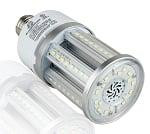Topmost Benefits Of Using LED Lights In 2021
Many people might be familiar with the term ‘LED lighting’ as it’s the latest trend in town when it comes to lighting. Still, today majority of people aren’t aware of the endless benefits one can avail of by switching over to LED lighting from the traditional ones. While some may have their doubts about buying it, as they think they are expensive than the other ones. Motion Sensored lights require less electricity to operate that’s why LED lights can be operated even at a low voltage. LEDs are extremely energy efficient and use up to 90% less power than traditional bulbs. It’s what makes LED an admired choice in rural areas where high voltage supply is limited or restricted.
Further in this article, we will discuss the factors that let you understand how important it is to use LED lighting.
Low maintenance
The first and the foremost vital factor of LED is the long lifetime helps to reduce the need to replace failed lamps, and this can further lead to major savings, especially in the cost of sending out maintenance staff. This also makes Sensored lights fixtures practical for installation in relatively inaccessible places; however, if there are works like cleaning the light fixture or doing electrical checks require to be carried out regularly, then the light sources could be replaced at the same time, opposing the advantage of low maintenance.
Efficiency
LEDs are considered to be high-efficiency light sources. The directional nature of light produced by LEDs allows the design of luminaries with higher overall efficiency.
Low power consumption
The low power consumption of outdoor lighting can lead to momentous energy savings that can mostly drive the installation of LED-based systems.
Brightness
while LEDs have high efficiency and put away a small amount of power, the devices generate a small number of lumen.
Heat
LEDs don't generate heat in the form of infrared radiation, which makes incandescent bulbs hot to the touch whereas the nonexistence of IR radiation let LED fixtures to be positioned in places where heating from conservative sources would cause a particular problem e.g. illuminating food or textiles; however, LEDs do generate heat at the semiconductor junction within the device.
lashing LEDs above their rated current causes the junction temperature to rise to levels where permanent damage may occur.
Small form-factors
LEDs are substantially very small and usually, high-brightness LED chips to compute 0.3 mm by 0.3 mm, even as high-power devices can be 1 mm x 1 mm or larger. There are numerous examples where the availability of small, high-brightness devices have enabled important market advancement.
Instantaneous switch-on
Undoubtedly, Motion sensor light is popular as they are switch on rapidly, even when cold, and this is a prime advantage for certain applications such as vehicle brake lights.
Color
Nowadays, LEDs are available in a wide range of brilliant, saturated colours though performance varies across the spectrum), and white devices are also available. Modules that have various coloured LEDs normally red, green and blue, or RGB that can be tuned to a wide variety of colours, and easily dimmed. RGB modules offer a much wider gamut of colours than white LEDs or other conventional white light sources, which is a particular advantage in applications such as back lighting liquid-crystal displays (LCDs).
RGB LEDs
LED characteristics to change with time, temperature and current, and from device to device. For RGB LEDs, the performance of diverse highlighted devices changes at various rates and this can also result in variation of lamp colour and intensity, and deprived reproducible.
White LEDs
The colour of white LEDs seems to be very inconsistent, although producers have lessened their binning ranges. White LEDs with similar correlated colour temperature can have various shade tints perceptible to the human eye.
Semiconductor processing
Fabricating LEDs is considered to be a complicated high-temperature process involving the growth of crystalline layers across the surface of a semiconductor wafer and the quality of such layers evaluates the properties of the LED.
Designability
Now, LEDs are available in various new design options, with the development of technology.
Environmental
LEDs do not have mercury and in various cases steps are being taken to reinstate lead-containing solders which are used majorly to fix LEDs to circuit boards with lead-free material. The LEDs are energy-efficient which makes them environmentally friendly.
Given, how nowadays most individuals are always looking for other energy sources that help them conserve more energy. In the near future, LEDs have become so popular and would slowly replace traditional lighting.

Comments
Post a Comment